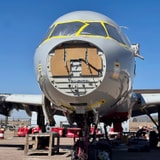rip these planes
See One Of The World's Biggest Aircraft 'Graveyards' Where Planes Go To Die — And Airlines Can Dissect Them For Parts

As the aviation industry hopes to reduce its carbon footprint, companies are coming up with new strategies to alleviate CO2 emissions.
In April, the Aviation Circularity Consortium, including Australian flag carrier Qantas and other groups, was created as a "joint mission to accelerate supply chain decarbonisation."
The plan is to use the 8,000 "end-of-life retired aircraft" that are sitting in deserts, jungles, and storage yards across the globe. Another 11,000 are expected to be available over the next 10 years.
[An aircraft at the Pinal Air Park in Arizona. Taylor Rains/Business Insider]
According to the consortium, the thousands of decommissioned aircraft offer "a new source of valuable circular materials" and address the "significant waste pollution challenges to the shrinking legal boneyards around the world."
These "graveyards" started filling up during the pandemic when airlines had to make drastic cost-cutting changes, including furloughing pilots, cutting routes, and indefinitely storing hundreds of planes in the desert.
[The dry clime is favorable for preventing corrosion. Christian Petersen/Getty Images]
One of these facilities is Pinal Air Park in Marana, Arizona — a small town located about 90 miles southeast of Phoenix.
[Pinal Airpark in Marana, Arizona. Ramon Purcell/Boneyard Safari]
As airlines started to shrink in 2020, hundreds of planes from all over the world flew to the 2,080-acre airpark.
With the influx, Pinal had to take special precautions to ensure the aircraft was ready to fly once travel eventually rebounded.
[An aircraft in reclamation Pinal Airpark in Marana, Arizona. Thomas Pallini/Insider]
Additional parking lots were built to handle the hundreds of planes, which continued to be filled into 2021 and 2022 with jets coming from places like the US, South Korea, UK, Australia, and Canada.
[AAS has its own landing gear shop to repair and overhaul parts to reuse on other planes. Taylor Rains/Insider]
However, with travel now roaring back and demand on track to surpass 2019 levels, AAS has gotten back to its roots — maintenance, repair, and overhaul (MRO).
Basic offerings include simple maintenance checks and on-demand repairs, like fixing the landing gear or inspecting the flight controls.
[There could be anywhere from 25 to 40 people working on an aircraft at once. Thomas Pallini/Insider]
These projects take a lot of manpower. Butler said the company targets 400-500 hours per day for widebodies and 300 per day for narrowbodies.
Because the checks are so expensive, many carriers opt to sell the aircraft when it gets to that stage in its lifecycle, which is typically every six to 10 years.
To see more photos of Arizona's aircraft 'graveyard,' head to Business Insider.